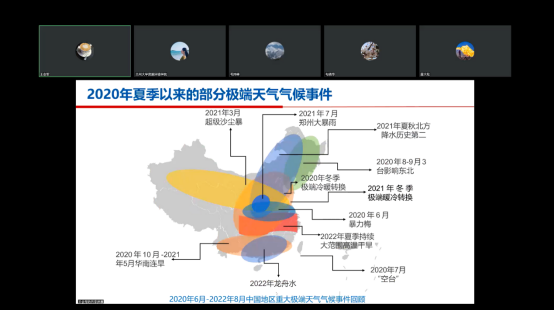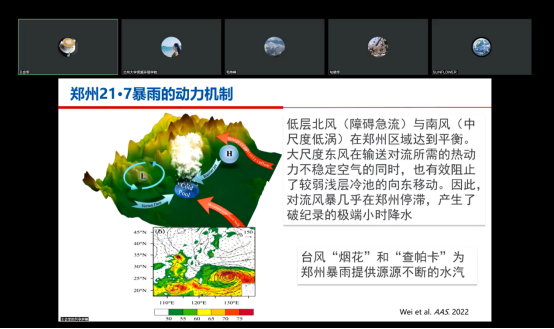On 8 December 2022, at the invitation of the College of Earth and Environmental Sciences of Lanzhou University and the Key Laboratory of Western China's Ministry of Environment and Education, academician Wang Huijun from Nanjing University of Information Engineering gave an online lecture entitled "Extreme events and their causes in China since the summer of 2020" to our students and teachers. The lecture was hosted by Prof. Gou Xiaohua and was conducted through an online meeting with about 380 teachers, undergraduates, and postgraduates from Lanzhou University and related universities and research institutes.

The causes of extreme weather and climate events in the context of global warming are important scientific issues of wide concern to the academic community and the public. Academician Wang Huijun first introduced the extreme weather and climate events that occurred in China in the past three years and the hazards they caused, such as the violent plum rains in the middle and lower reaches of the Yangtze River in June 2020, the "empty platform" phenomenon in South China in July and the heavy rainstorm in Zhengzhou in July 2021. Next, Academician Wang Huijun presented a detailed analysis of the causes of these extreme weather and climate events in the form of a timeline. Numerical simulation experiments were used to reveal the causes of extreme weather events in the context of global warming, taking into account the coupled sea-land-air processes. Taking the July 2021 heavy rainstorm in Zhengzhou as an example, Academician Wang Huijun integrated the influence of large-scale atmospheric circulation and mesoscale local airflow changes and topographic factors to reveal the dynamical mechanism of the Zhengzhou rainstorm and demonstrated through model simulation results that global warming had contributed to the occurrence of the Zhengzhou rainstorm. Finally, Academician Wang Huijun gave a brief summary and outlook of the presentation. He pointed out that extreme weather and climate events in China are persistent, clustered, and complex in nature, and were related to human activities and coupled sea-land-air processes; extreme weather and climate events were often high to catastrophic, with low and difficult prediction levels, and our ability to cope with these events needs to be strengthened urgently. The in-depth and colorful presentation by Academician Wang Huijun enabled the students and teachers to understand the possible links between extreme weather and climate events and elements of the Earth system, such as the atmosphere, sea temperature, sea ice, and topography, and to deeply appreciate the characteristics of the Earth system that involve the whole body.

After the presentation, Academician Wang Huijun had a full discussion with many students and teachers on academic issues related to the causes of extreme weather and climate events and the links between various extreme weather and climate events, as well as an outlook on how ancient and modern climate research could be integrated with each other from various perspectives. The presentation enriched the students' understanding of the causes of extreme weather and climate events and left a deep impression on the students and teachers.
Expert profile:
Wang Huijun, born in January 1964, is an academician of the Chinese Academy of Sciences and Director of the Academic Committee of Nanjing University of Information Engineering. He is also the President of the Chinese Meteorological Society, the Chief Scientist of the National Natural Science Foundation of China (NSFC) Basic Science Centre Project "Climate System Prediction Research Centre", the Chief Scientist of the NSFC Major Project "Mechanism, Prediction and Forecasting of Extreme Climate and its Ecological and Environmental Impacts in the Middle and High Latitudes of Asia", and the Vice Chairman of the Chinese Society of Quaternary Sciences. He is a member of the Norwegian Academy of Technology, an honorary professor at the University of Bergen, a member of the Joint Scientific Committee of the World Climate Research Programme (WCRP), the Chairman of the WCRP China Committee, and a member of the Norwegian Polar Research Institute and deputy editor of the Bulletin of Science and editor-in-chief of the Journal of Atmospheric Sciences. He has long been involved in research in the field of climate change, short-term climate prediction and paleoclimate.